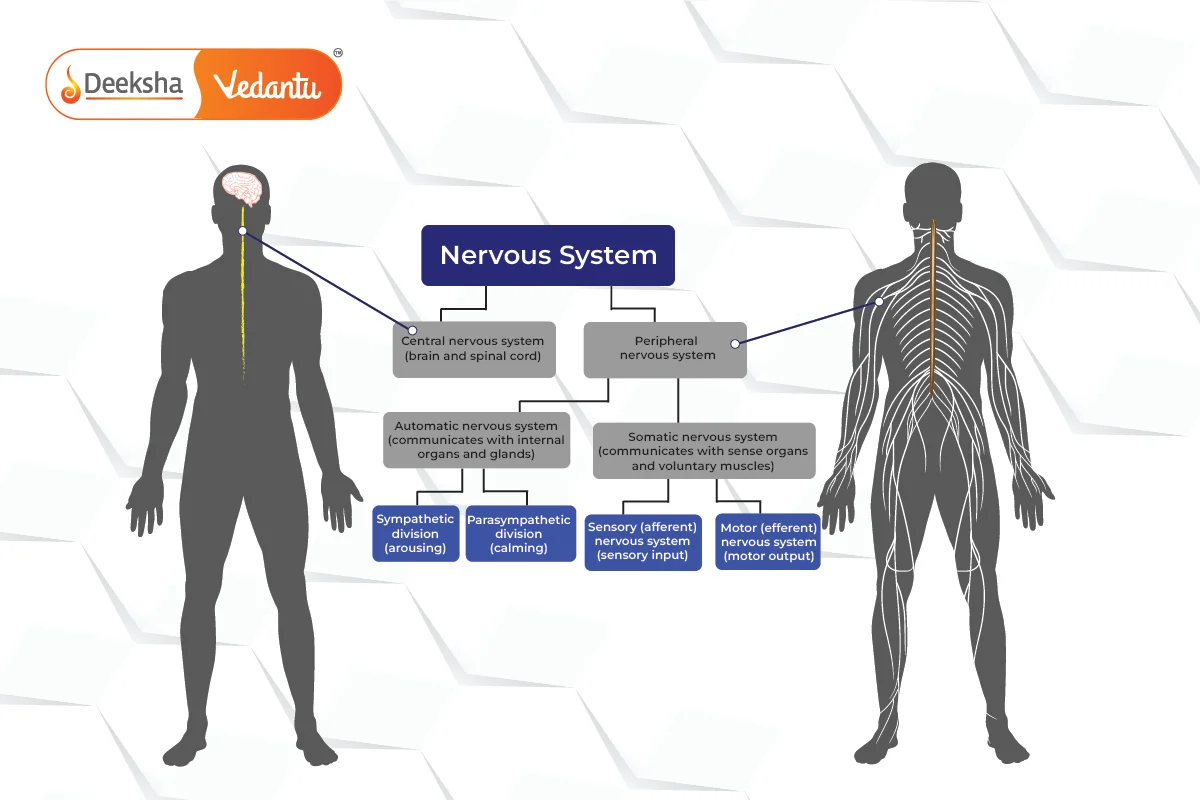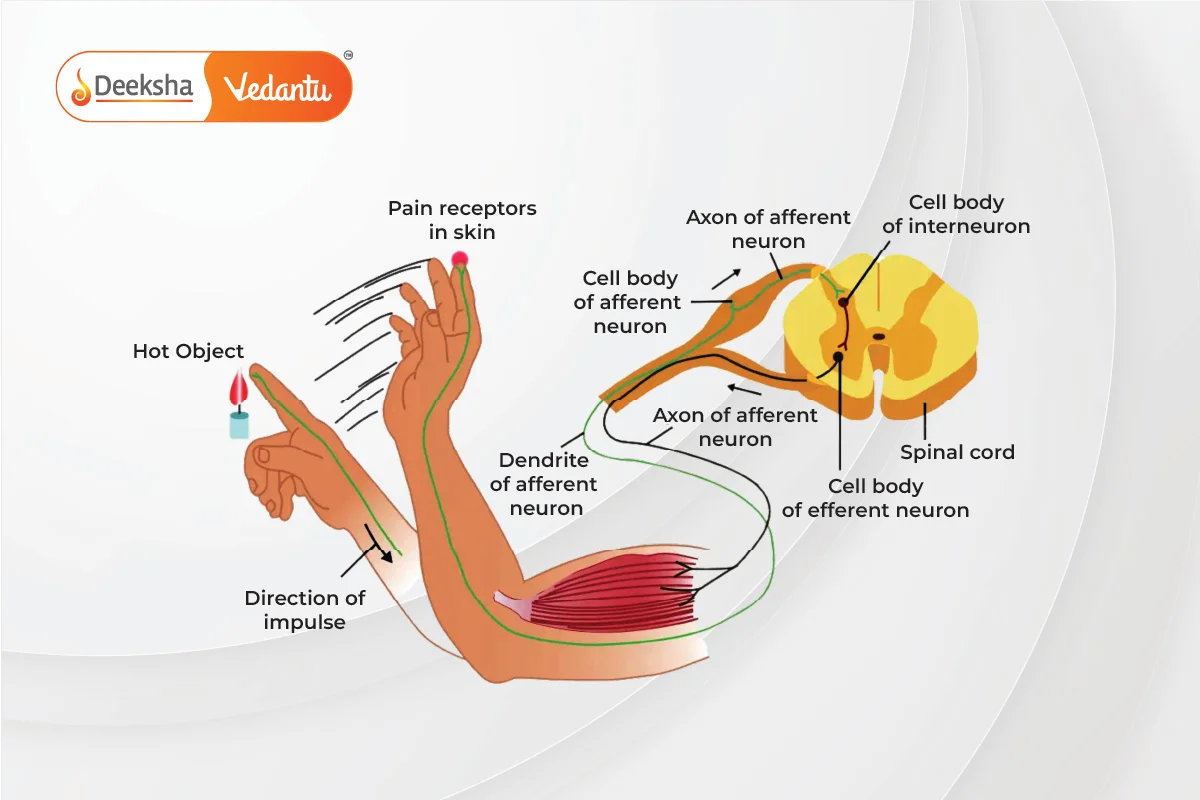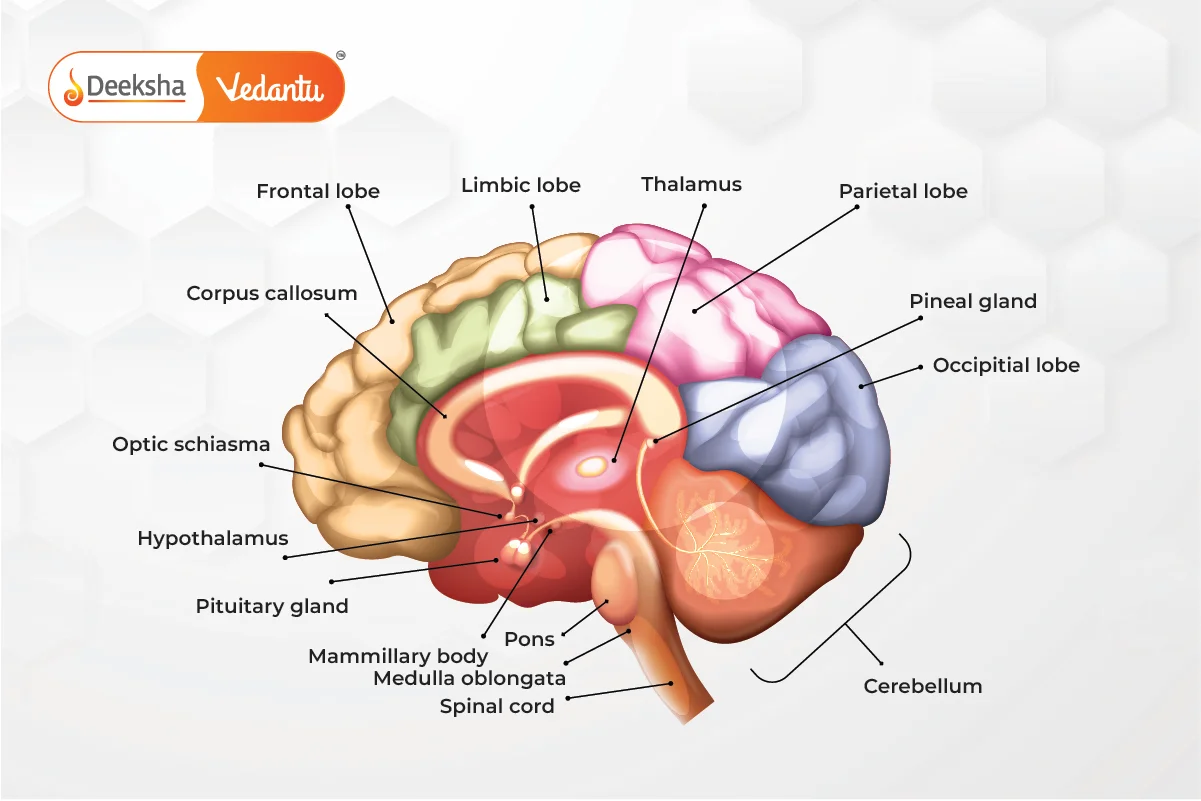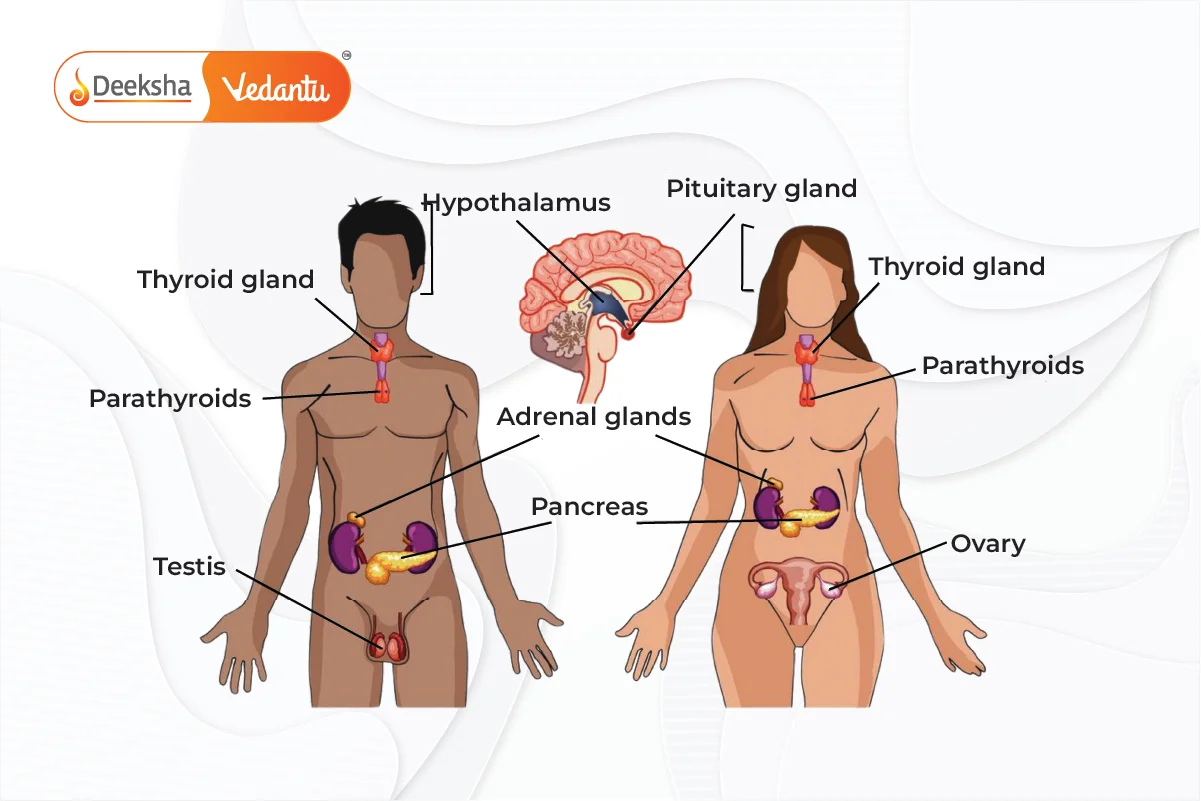Introduction
Control and coordination in organisms are critical for responding to environmental changes and maintaining homeostasis. In animals, this is primarily achieved through the nervous system and the endocrine (hormonal) system. In plants, coordination occurs through plant hormones. These systems work together to ensure that organisms can detect stimuli, respond appropriately, and regulate internal processes such as growth, movement, and metabolism.
The Nervous System in Animals
The nervous system allows animals to detect stimuli (changes in the environment) and respond to them. It is a highly organized system made up of neurons, which are specialized cells capable of transmitting electrical impulses.

Structure of a Neuron
A neuron (nerve cell) is the basic unit of the nervous system. Neurons are capable of receiving and transmitting signals. Each neuron has three main parts:
- Cell Body (Soma): Contains the nucleus and other organelles responsible for the neuron’s metabolic activities.
- Dendrites: Short, branched extensions that receive signals from other neurons or sensory receptors.
- Axon: A long, thin fiber that transmits signals away from the cell body toward other neurons or effectors (muscles, glands).
At the end of the axon, there are terminal branches that end in synaptic knobs, which transmit the signal to the next neuron or target organ via chemical neurotransmitters.
Nerve Impulse Transmission
The transmission of a nerve impulse occurs in two stages:
- Electrical Transmission: An electrical impulse, known as an action potential, travels along the axon. The axon is often covered by a myelin sheath, which speeds up the transmission of the signal.
- Chemical Transmission: At the synapse, where two neurons meet or where a neuron meets a muscle, the electrical signal triggers the release of chemical messengers called neurotransmitters. These chemicals cross the synapse and bind to receptors on the next neuron, transmitting the signal.
Types of Nervous Systems

The nervous system is divided into two main parts:
- Central Nervous System (CNS): Consists of the brain and spinal cord. It processes information and coordinates responses.
- Peripheral Nervous System (PNS): Consists of all the nerves that connect the CNS to the rest of the body. It is further divided into:
- Somatic Nervous System: Controls voluntary actions (e.g., movement of limbs).
- Autonomic Nervous System: Controls involuntary actions (e.g., heart rate, digestion).
Reflex Actions and Reflex Arc
A reflex action is an automatic, rapid response to a stimulus, which occurs without conscious thought. Reflex actions protect the body from harm (e.g., pulling your hand away from a hot object).

Reflex Arc
The reflex arc is the neural pathway involved in reflex actions. It consists of the following components:
- Receptor: Detects the stimulus (e.g., skin receptors detecting heat).
- Sensory Neuron: Carries the signal from the receptor to the spinal cord.
- Interneuron: Located in the spinal cord, it processes the information and passes it to a motor neuron.
- Motor Neuron: Carries the response signal from the spinal cord to the effector.
- Effector: The muscle or gland that responds to the stimulus (e.g., contracting muscles to withdraw your hand).
Example: If you accidentally touch a hot object, the sensory receptors in your skin detect the heat and send a signal to the spinal cord via sensory neurons. The spinal cord processes this information and immediately sends a signal back through motor neurons, causing the muscles in your hand to contract and pull away from the hot object.
Human Brain
The human brain is the control center of the nervous system. It is highly specialized and controls both voluntary and involuntary activities.

The brain is divided into three main parts:
- Forebrain:
- Cerebrum: The largest part of the brain, responsible for higher cognitive functions such as thinking, reasoning, memory, and voluntary muscle movement.
- Thalamus: Acts as a relay station, transmitting sensory information to the cerebrum.
- Hypothalamus: Regulates basic body functions like hunger, thirst, body temperature, and emotions.
- Midbrain:
- Located between the forebrain and the hindbrain, the midbrain controls reflexes related to vision and hearing. It also coordinates certain involuntary actions.
- Hindbrain:
- Cerebellum: Responsible for balance, posture, and coordination of voluntary movements.
- Medulla Oblongata: Controls involuntary functions like heart rate, blood pressure, and respiration.
- Pons: Connects different parts of the brain and assists in regulating breathing.
Functions of the Brain
- Voluntary Actions: Controlled by the cerebrum (e.g., speaking, walking).
- Involuntary Actions: Controlled by the medulla and hypothalamus (e.g., heartbeat, breathing, digestion).
Protection of the Brain:
The brain is protected by the cranium (skull), a set of three membranes called meninges, and cerebrospinal fluid (CSF), which acts as a cushion against mechanical shocks and helps remove metabolic wastes.
Coordination in Plants
Plants respond to environmental stimuli like light, gravity, water, and touch without a nervous system. This response is controlled by plant hormones and occurs through tropisms (growth movements).
Types of Tropisms
- Phototropism: Growth in response to light. Shoots exhibit positive phototropism (grow towards light), while roots exhibit negative phototropism (grow away from light).
- Geotropism: Growth in response to gravity. Roots exhibit positive geotropism (grow towards the gravitational pull), while shoots exhibit negative geotropism (grow against gravity).
- Hydrotropism: Growth in response to water. Roots exhibit positive hydrotropism as they grow towards areas with more moisture.
- Thigmotropism: Growth in response to touch. Tendrils of climbing plants, like pea plants, wrap around a support when they come into contact with it.
Plant Hormones (Phytohormones)

- Auxins: Promote cell elongation and are responsible for directional growth (e.g., bending of plants towards light).
- Gibberellins: Stimulate stem elongation, seed germination, and flowering.
- Cytokinins: Promote cell division and delay aging in leaves.
- Abscisic Acid: Inhibits growth and promotes dormancy, especially during unfavorable conditions (e.g., drought).
- Ethylene: A gaseous hormone that promotes ripening of fruits.
Example: Auxins accumulate on the shaded side of a plant, causing cells to elongate more on that side, which results in the plant bending toward the light.
Hormonal Coordination in Animals
The endocrine system regulates body functions through hormones, which are chemical messengers secreted by endocrine glands. Hormones travel through the bloodstream to target organs, where they trigger specific responses.

- Pituitary Gland (Master Gland):
- Secretes growth hormone (regulates growth), ADH (controls water balance), and TSH (stimulates the thyroid).
- Thyroid Gland:
- Secretes thyroxine, which regulates metabolism. A deficiency of iodine in the diet can lead to goitre, an enlargement of the thyroid gland.
- Adrenal Gland:
- Secretes adrenaline during stressful situations, preparing the body for “fight or flight” by increasing heart rate, blood pressure, and breathing rate.
- Pancreas:
- Secretes insulin and glucagon to regulate blood sugar levels. Insulin lowers blood sugar, while glucagon raises it.
- Ovaries (in females):
- Secrete estrogen and progesterone, which regulate menstrual cycles, pregnancy, and secondary sexual characteristics.
- Testes (in males):
- Secrete testosterone, responsible for the development of male reproductive organs and secondary sexual characteristics.
Feedback Mechanism
Hormonal regulation is often controlled by feedback mechanisms. For example:
- When blood sugar levels rise, the pancreas secretes insulin to lower it. When blood sugar falls, insulin secretion decreases, and glucagon secretion increases to raise blood sugar levels.
Differences Between Nervous and Hormonal Control
| Aspect | Nervous Control | Hormonal Control |
| Nature of Signals | Electrical impulses transmitted by neurons | Chemical messengers (hormones) carried by blood |
| Speed of Response | Very fast (milliseconds) | Slow (minutes to hours) |
| Duration of Response | Short-lived | Long-lasting (can last for days or weeks) |
| Target | Specific muscles or glands | Target cells throughout the body |
| Mode of Transmission | Along nerves | Via bloodstream |
| Example | Reflex actions, voluntary movements | Regulation of growth, metabolism, and reproduction |
Practice Questions
Q1: Explain the process of reflex action with an example.
- Answer: A reflex action is an automatic, quick response to a stimulus. For example, touching a hot object triggers a reflex arc, where sensory neurons send a signal to the spinal cord, which immediately sends a response via motor neurons to the muscles, causing the hand to withdraw.
Q2: How does the endocrine system maintain homeostasis?
- Answer: The endocrine system maintains homeostasis through feedback mechanisms. Hormones like insulin and glucagon regulate blood sugar levels, while thyroxine controls metabolic rate, ensuring that the body’s internal environment remains stable.
Q3: What are the differences between voluntary and involuntary actions?
- Answer: Voluntary actions are consciously controlled by the brain (e.g., walking), while involuntary actions occur without conscious control (e.g., heartbeat, digestion).
FAQs
The synapse is the junction between two neurons or between a neuron and a muscle. It allows electrical impulses to be transmitted from one neuron to another or from a neuron to a muscle via chemical neurotransmitters.
Hormones like growth hormone (from the pituitary gland) and thyroxine (from the thyroid gland) regulate physical growth, metabolic rate, and development.
Plants respond to light through phototropism, a process regulated by auxins. Auxins cause the cells on the shaded side of the plant to elongate more, making the plant bend towards the light.
The cerebrum is responsible for higher cognitive functions like thinking, memory, decision-making, and voluntary actions like movement.












Get Social